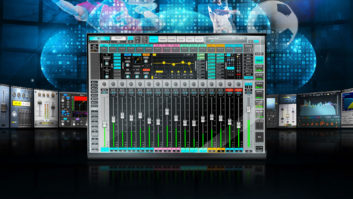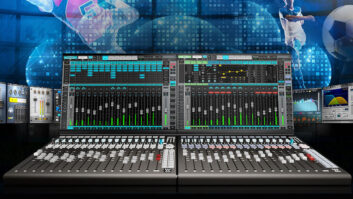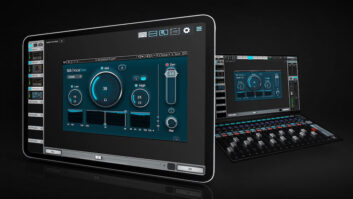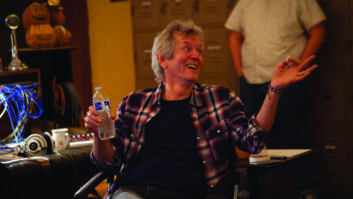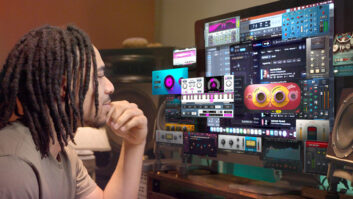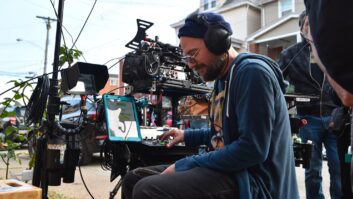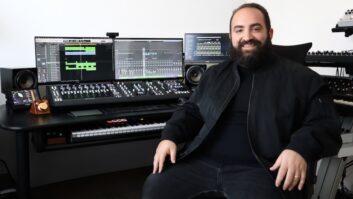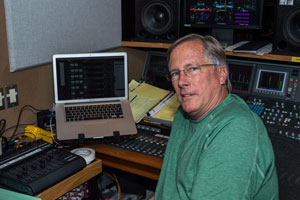
Broadcast production mixer Michael Abbott
As NBC’s Emmy Award-winning TV talent competition The Voice entered its live performance phase, leading up to the crowning of winner Josh Kaufman in May, broadcast production mixer Michael Abbott (pictured) reports that he inserted the Waves SoundGrid processing platform and Waves MultiRack with plug-ins into the show’s vocal microphone signal chains, running them through a Calrec Alpha console.
Abbott’s resumé includes American Idol, Shark Tank, Survivor, Rising Star, The X Factor, and productions such as the annual Grammy Awards.
By using Waves plug-ins on the microphones used by the judges, host, contestants and guests on the competition, Abbott says he was able to significantly improve the clarity and quality of the live broadcast audio.
“I typically mix in environments that have a very high noise ambient floor [HVAC, fans, etc.], so you have to utilize these tools,” says Abbott. On The Voice, Abbott, with NEP Denali broadcast systems engineer Hugh Healy, integrated the redundant Waves SoundGrid server, together with an 8-fader MIDI controller, into the company’s Denali Silver truck. Abbott mixes the production’s audio elements, and the music mix is created by Randy Faustino in his Creative Sound Solutions mobile production vehicle parked nearby.
Abbott says he selected the SoundGrid system following discussions with Brian Riordan, owner of Levels Audio Post in Hollywood, who mixes the audio for the preliminary episodes of The Voice. “For the five live weeks, we try to create the same kind of sound-field as the posted shows, which is the majority of the season,” says Abbott. “What SoundGrid has allowed me to do is emulate the intelligibility and crisp sound Brian has in his post-production mix and transfer it to a live broadcast environment.”
Abbott previously used five outboard noise processing hardware units on the lavalier mics worn by Adam Levine, Shakira, Usher and Blake Shelton—the celebrity judges on certain seasons of The Voice—plus the contestant’s handheld mic. Abbott says that now, through the judicious use of Waves plug-ins, he has been able to significantly clean up the singing and dialog channels by controlling the levels of the enthusiastic audience and reducing noise from the air conditioning and loud on-set equipment which was leaking into the live microphones.
“For instance,” Abbott says, “for Shakira’s track, I have two Waves Noise Suppressors on her mic. I use the first WNS to control noise from 100 to 1,200 Hz. I filter a second WNS on the same track starting at 1,200 Hz—a pass-through from the first WNS—on up to 9 KHz cycles. I don’t need all the spurious high end; there’s some severe high-end hisses and transients on this stage.”
Abbott has MultiRack mapped to hot buttons on his MIDI controller for quick access to the microphone channels being processed. “The exciting thing about MultiRack is that it’s also given me the ability to use plugins to warm things up,” he says. “I had a Waves Platinum bundle that I applied to SoundGrid. I’m using API 550s on the front end of the mics. The C6 Multiband Compressor is a spectacular tool, too. I also utilized the CLA-76 compressor/limiters; the 76 emulation smooths out the peak transients. I’ve only scratched the surface with what this system can do.”
The biggest challenge is host Carson Daly’s handheld mic, Abbott reports. “There’s no way I can put a lav mic on him. But with that presence of a hand mic in a live environment, and with four coaches who want to speak spontaneously, I had to use the Dan Dugan E-1 automixing hardware. Now I use the Waves Dugan Automixer in SoundGrid.”
The voice-activated Waves Dugan Automixer plug-in automatically controls mic gains, reducing interference from adjacent mics and attenuating background noise. Andrew “Fletch” Fletcher, the show’s front-of-house mixer, also employs the Dugan Automixer and WNS plugins on a DiGiCo SD7 console to prevent unwanted coloration from the house P.A. system from getting into the microphones and adversely affecting Abbott’s broadcast mix.
Abbott says he did not originally plan to implement SoundGrid until the next season of The Voice, which is scheduled to open in fall 2014 on NBC. But he and Healy were so impressed when they were evaluating the system that they decided to try it. “We really didn’t have the intent to put it in place, but we rolled the dice after quite a bit of vetting—overall it’s been very robust. Hugh and I were both stunned by how seamless the transition was,” Abbott reports.
For more information, visit www.waves.com/live-sound.
